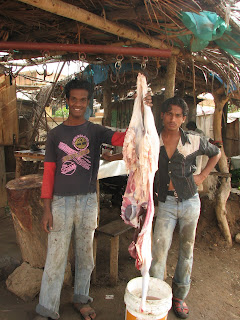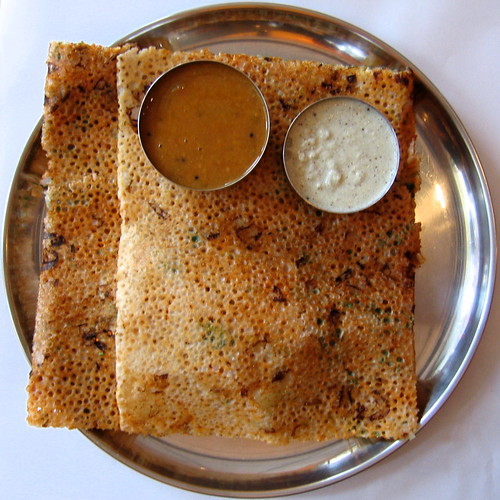My time at Swami Vivekananda Youth Movement was one of those experiences where you look back and you say, “That was only one week?” I guess I’d say that because each and every single day that I was there was filled with opportunities and chances to take part in something I had never seen before. Whether it was the hospital rounds or mobile clinics or trips to the ayurvedic hospital, each stop along the way taught me something about the vision of the organization. I’ve been able to see how coming in with the desire to observe public health initiatives, that “public health” is so much more than what can be fit in the confines of a hospital or office.
I mentioned Partners in Health because many people are familiar with Dr. Paul Farmer’s organization and have read Tracy Kidder’s book, Mountains Beyond Mountains. Swami Vivekananda Youth Movement began with the very same vision and reason – tribals living in the rural areas of south Karnataka were flooded out of their homes by the construction of a dam in the areas where they were living. Out of compassion and concern for their healthcare – a group of doctors in the 80’s began SVYM to provide healthcare to these tribals with whatever it took.
But they realized after a couple years that treating the needs of these people with their medical skills could only do so much. What happens if you treat a child for diarrhea and he went back to his village and drank the very same dirty water and got sick again? What if an entire generation of girls grew up and none of them could read? How could you teach people that the polio vaccine was something to save you from a potentially life threatening disease and not a way to make you infertile?
And so they started schools. They began promoting clean sanitation and water practices. They envisioned creative initiatives to teach women about family planning and ante-natal care. For many of the tribals and non-tribals alike, there were many obstacles that needed to be overcome before a sincere trust in SVYM was garnered. But for every obstacle, there was an innovative solution devised that was alongside the vision. People were taught that it was okay and desirable to have a toilet in the vicinity of their house. People were charged a mere 2 rupees to reinforce the value of seeking healthcare even if nothing was wrong with them.
One of the simplest but profound lessons that I learned at my one week at SVYM started even before I got on the plane to Bangalore. I’d once heard a story of a group of aid workers in Africa who decided to bless the tribals they were working with by giving them a huge batch of eggs as a gift. Delighted, the tribals accepted the eggs and consequently killed all of their chickens for food, not realizing that the eggs given to them by the workers would eventually run out. When they finished their eggs, they were left with a huge challenge that the workers were not there to help them through – how were they going to get more eggs? Similarly, I heard a story like this one at SVYM. At one point, the government had allotted a certain amount of money for the construction of toilets in the rural areas. The people were left asking though, “What’s a toilet?” “Why would I want that?” “Where am I going to get the water to flush it?”
The simple lesson to learn here is that development, aid, medical, whatever work to people must meet the needs of the people. It’s not that the intentions of the African workers or the Government of India were bad. They probably meant the best for the people they were serving. But somewhere along the line, there was a mishap in understanding the true needs of the people they intended to help. And that was one of the most valuable take-aways from SVYM. Every initiative, program, and extended arm to the community was created with one purpose: meeting the needs of the people in the surrounding communities.
So what’s next? I’m not really sure. I was having dinner with Sridevi and Seetharam’s family the night before I left and I remember asking the same question. Before I left for India, I got to meet with a professor in Michigan’s School of Social Work and I remember inquiring about any possible work opportunities in the fall. He mentioned the plethora of grassroots initiatives that he was involved in across southeast Michigan and that there were plenty of opportunities for students who wanted to take up a project for themselves. He even pointed to a box of robotics Legos kit that he was hoping to use to start an after school program for kids at a local low-income middle school. Somewhat disappointed that he hadn’t offered a regular eight hour a week job, I nodded and told him I would keep in touch.
But thinking back the lessons taken from SVYM – I’d have to say that I’m seriously reconsidering that box of Legos Robotics for this upcoming fall!
Here are some last pictures from my final days at SVYM:

I decided to extend my stay for one extra day, which turned out to be a pretty good decision because it would’ve been pretty hectic to fly out of Bangalore the day after the bomb attacks. On Saturday, I went on a mobile again, this time into the deep forests of Karnataka, bordering the state of Kerala. I was told that this mobile was almost like a mini-safari, with elephants, tigers, leopards, deer, and water buffalo galore. I saw everything except for tigers and leopards (luck is really on your side if you do). Here are a pack of elephants that we ran into the first fifteen minutes after entering the forest.

A shot of child getting medical treatment. Life for the tribals in the forest is very tough. I was told that many people survive on one meal a day – there are just very few viable economic opportunities around. I noticed throughout the day that there was a pattern of conditions that we were encountering throughout the day. Many of the children were coming to us with fungal and parasitic infections, like scabies. Many of the women were coming with conditions related to ante-natal care. For the children with the fungal and parasitic infections, the reason for developing such conditions is none other than poor sanitation and hygiene. You can see why there is a great need for education and advocacy campaigns to prevent these preventable conditions.

On the way back from the mobile clinic, I asked one of the health facilitators what a tree house (there were many on every field) was doing in the middle of India (I assumed they were for kids to play in). Turns out that these are real tree houses used to protect the crops from animals eating and trampling over their crops. People sleep in the tree houses at night and if any destructive animal were to come around, they would throw noise making devices onto the ground to scare them away.
Shot with all the doctor's kids that lived next to me. On my first day I came to them, asking them to play cricket. I got to hit my first couple of balls ever - and got destroyed by the bowling of the 8 year old standing right next to my right arm.

Final shot with Dr. Sridevi and Dr. Seetharam's family. They have two kids Amritha and Sriram, a housekeeper named Sughita, and Dr. Sridevi's grandma living them as well. Dr. Seetharam is coming to New Delhi this week for a meeting so hopefully we'll get to meet up and talk over dinner!
















































